The Nitecore P16 TAC is a 1000 lumen flashlight designed for law enforcement and hunting. It features a Cree XM-L2 U3 emitter, tail and side switches with momentary on, and springs both front and rear to absorb shock and recoil. It has 4 output modes and runtimes between 1h 15 min and 600h, per specifications.
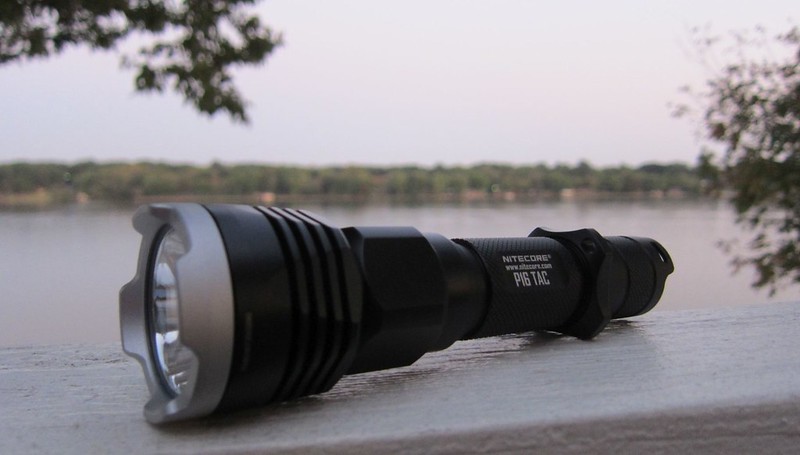 [/url]
[/url]
Here is a summary of the XT2CR as tested, for those not inclined to read the full review:

The Nitecore P16 TAC is an upgrade to the original P16 released in the fall of 2013.
Skip to the commentary section at bottom to read my subjective notes on the P16 TAC and changes from the P16.
Disclaimer: This light was provided free of charge by Nitecore Store for review.
Unboxing
The P16 TAC is packaged in a black and yellow retail box in the same style as other Nitecore flashlights.
The box front promotes the 1000 lumen output, 300 meter beam distance, impact absorption spring, 4 brightness levels, and 3 special modes.

The back of the box has verbiage promoting much of the same information as was found on the front. It declares the P16 TAC an "ultimate lighting tool for tactical users and hunters".
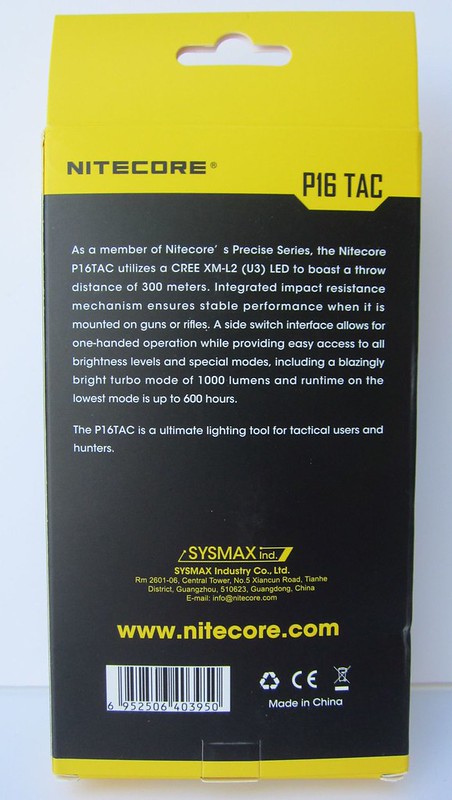
One left side of the box promotes these hunting and tactical uses.
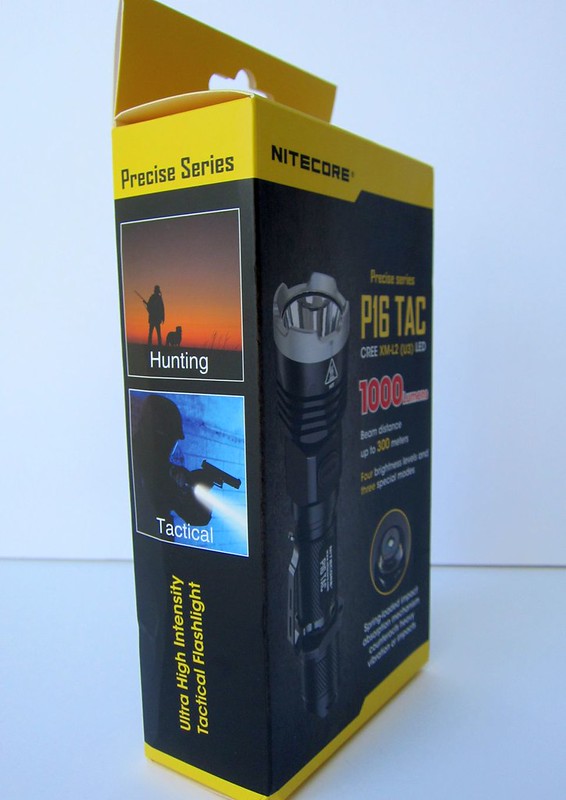
The right side has the P16 TAC's specifications.
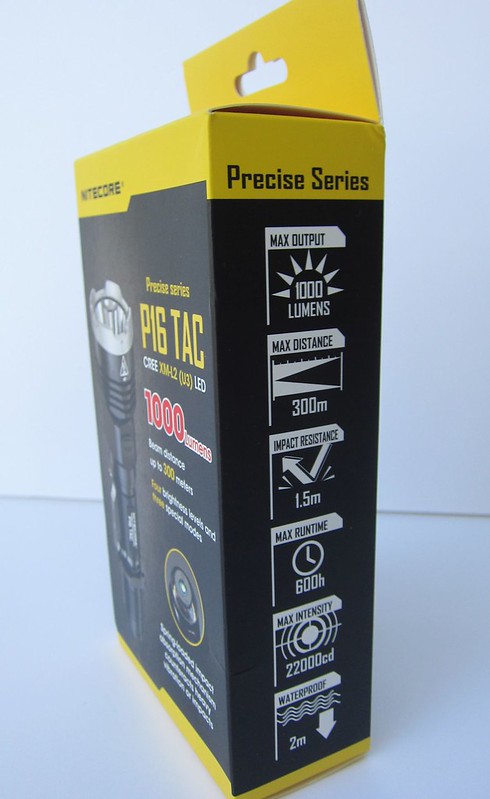
Inside the box a plastic tray holds the P16 TAC. The accessories are tucked next to the P16 TAC from the underside of the tray.
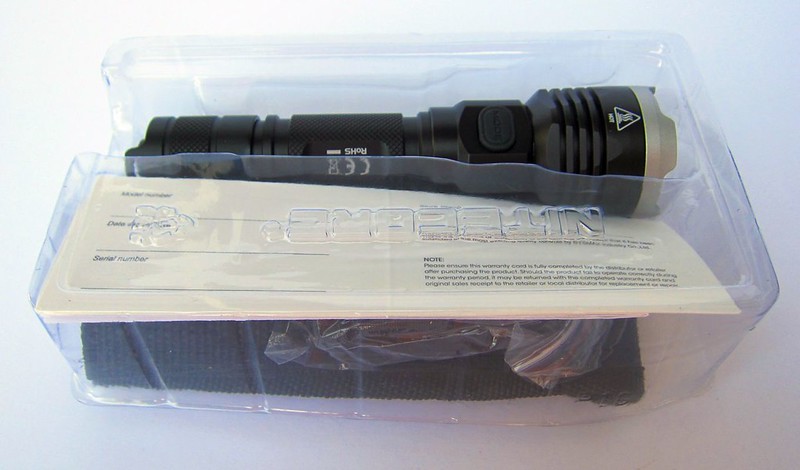
Included is a holster, manual, warranty card, spare o-rings, spare tail switch boot, pocket clip, cigar ring, and lanyard.

The manual is in 9 languages (English, Spanish, German, French, Polish, Japanese, Romanian, Chinese, and Korean); each language's section is complete as the text is quite small.
It is available online here:
Nitecore backs the P16 TAC with a 5 year warranty.
Design
The P16 TAC is a traditional design with a single 18650 size battery tube and larger reflector. The light measures 154 mm long, 25.4 mm wide at the body, and 40 mm at the head. Weight is 142 g without battery. These are my measurements; Nitecore's specifications match other than the length is reported at 151 mm and weight at 136 g.
The 40 mm head size makes it compatible with a variety of filters, wands, and diffusers available from Nitecore. The 25.4 mm (1 in) body size is the standard size for weapon and bicycle mounts.
Here is the P16 TAC alongside other single 18650 flashlights.
L to R: Nitecore TM03, Nitecore P16 TAC, Zanflare F1, Klarus XT2CR, Convoy S2+, ThorFire VG-15S, Nitecore Concept 1.
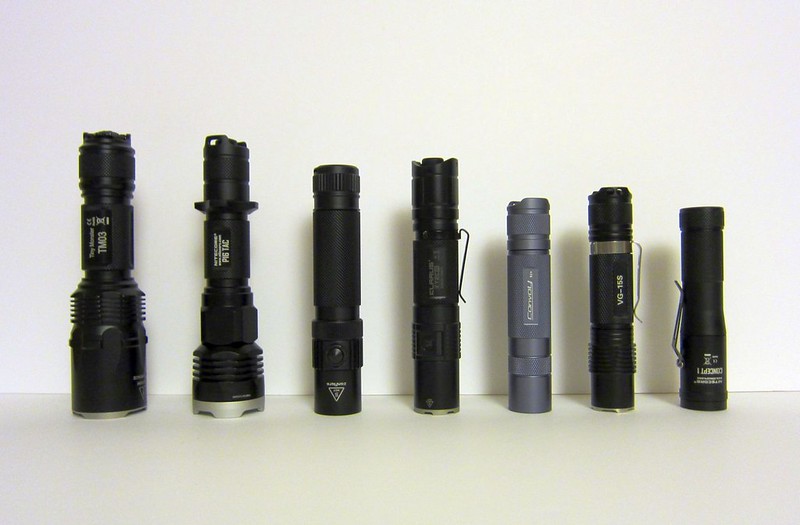
The head of light has a silver-colored crenulated bezel, glued in place and non-removable. Behind the bezel on the side of the head is a "HOT" warning nicely aligned with the mode switch. The glass is AR-coated.
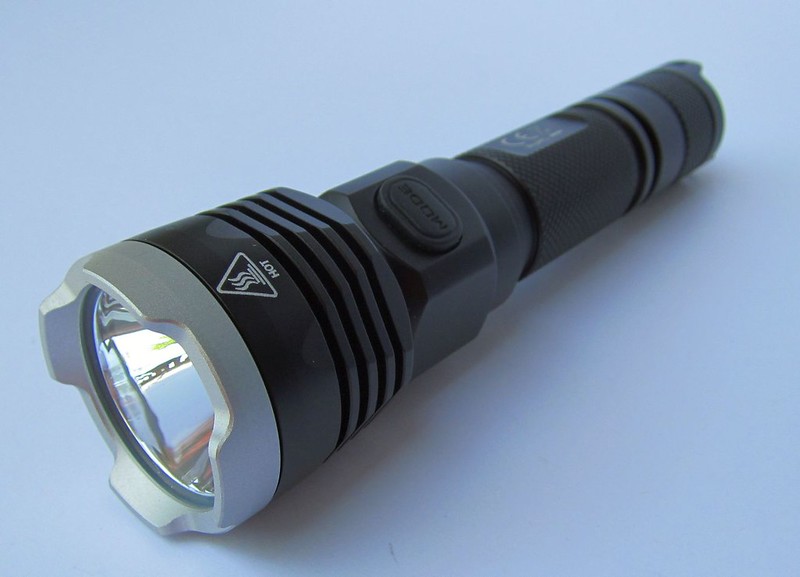
The reflector is smooth and deep. It had one small but insignificant ripple-like imperfection near the outer edge (visible at top in this picture). The beam was unaffected.
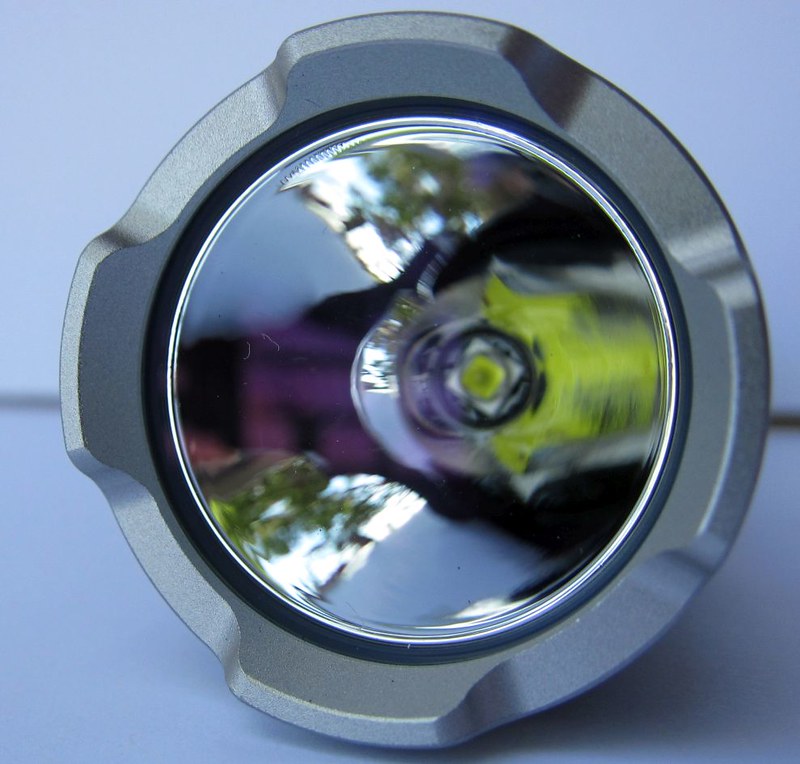
The XM-L2 U3 LED is perfectly centered.

The side of the head has four cooling fins ahead of the pentagonal section housing the Mode switch. The mode switch is not backlit.
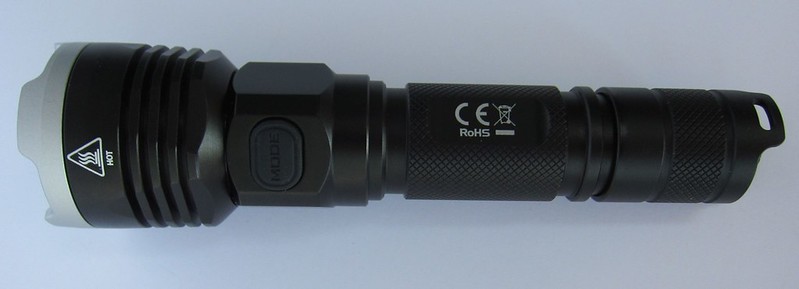
The Nitecore Logo, website, and model name are located on the battery tube. Knurling is consistent and adds a mild amount of grip to the P16 TAC.
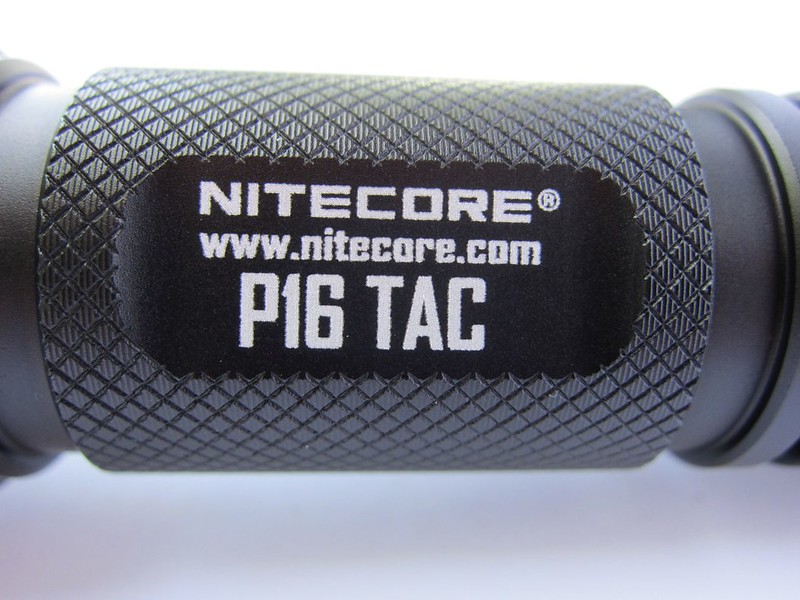
The opposite side of the battery tube has the registration and disposal information.
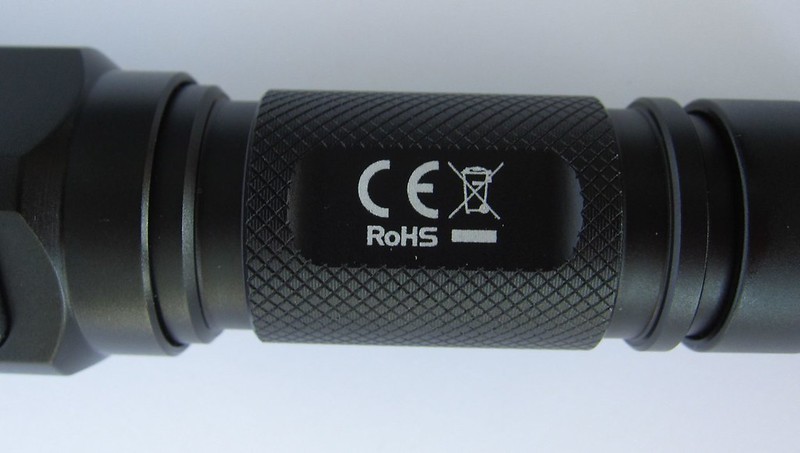
The reversible titanium-plated stainless pocket clip attaches to the battery tube. I would expect most users to use the holster instead of pocket clip given the light's size, but the flexibility is nonetheless nice.
The clip attaches securely but is still reasonably easy to remove and replace without damaging the anodization thanks to the upturned ends on the clip's arms.
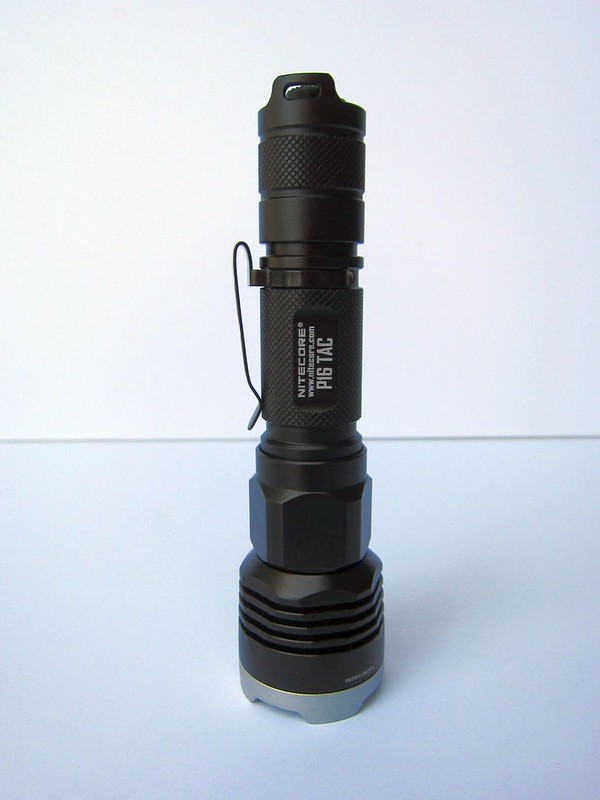
It can be attached for head-up carry/attachment as well.

The cigar ring attaches ahead of the tail cap and provides useful grip when holding the P16 TAC overhand and prevents the light from rolling away when laid down. It also provides a lanyard attachment point redundant with the tail's holes. When the cigar ring is in place the pocket clip cannot be attached head-down.
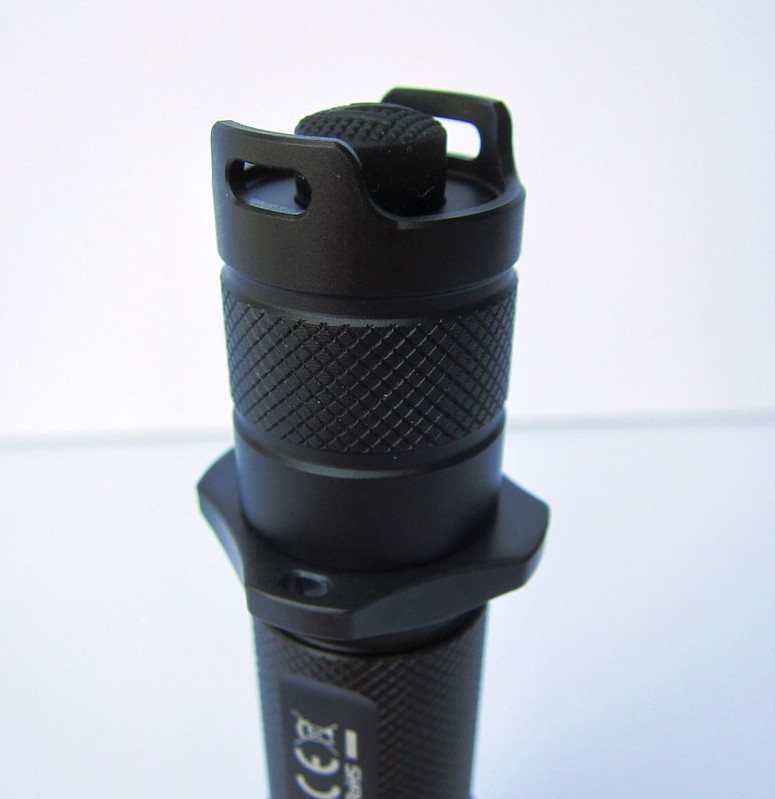
The tail has a forward clicky switch that enables momentary on; if switch is half-pressed, the light will turn on in whatever mode was last used while the switch is held. Nitecore includes a spare rubber switch boot in case the original suffers damage in use. The switch boot has the Nitecore "N" and has excellent feel. Pressure to activate the switch is moderate – not too easy and not too stiff.
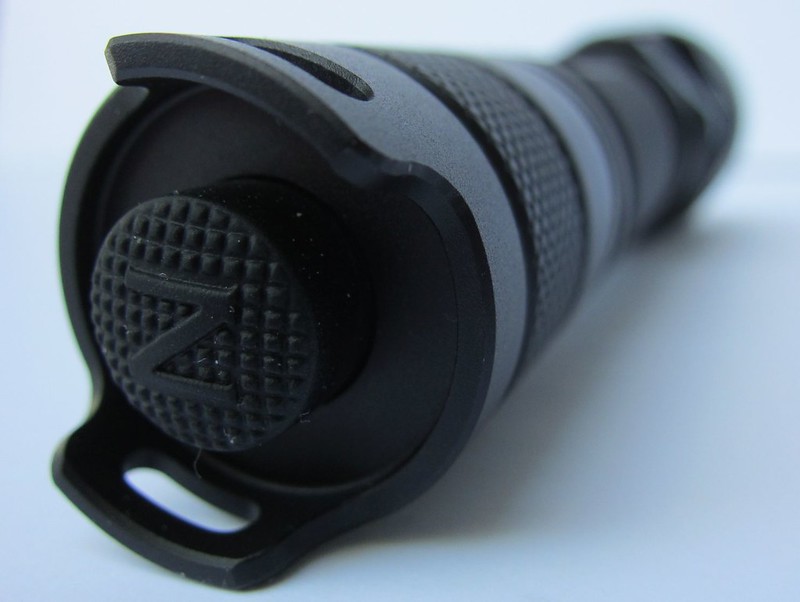
Nitecore offers a remote switch that can be used with the P16 TAC.
Two flat sections on tail provide lanyard attachment points and tailstand capability, though tailstanding requires a flat surface.

Inside, the tail has a gold-colored spring. The tail switch assembly can be disassembled (for cleaning or boot replacement) using a set of snap ring pliers to unscrew the retaining ring.
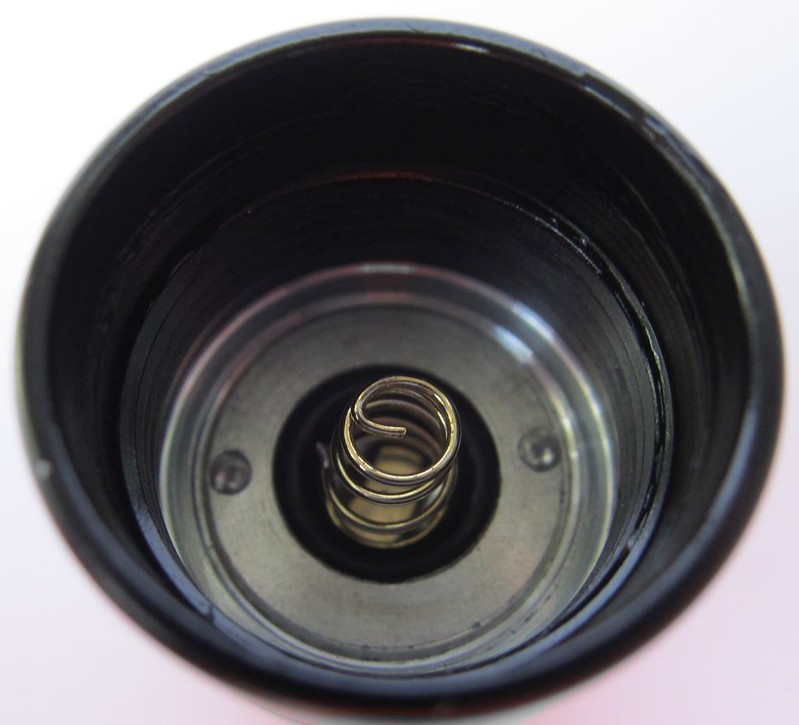
Threads are triangular cut and very well lubricated. They are also anodized, so a quarter turn of the tail will mechanically lock out the P16 TAC. An o-ring prevents water ingress to achieve the IPX-8 (2m) rating.

The P16 TAC is designed as a weapon-mountable tactical light; because of this it has a spring on the head-end as well to absorb shock – as advertised on the front of the box. The spring is not visible, blocked by the polarity protection disc used by Nitecore to protect against incorrect battery insertion. Button top batteries are required; flat tops will not function.

(It's also difficult to photograph as the battery tube is glued into the head.)
The included holster holds the PD16 TAC with the head up. It works with the pocket clip or cigar ring in place. It has a belt loop, a hook-and-loop strap, and a D ring so it can be carried a variety of ways.
Performance
Beam
The smooth reflector produces a very defined hotspot. The corona is a little jagged but relatively small. While most of the lumens go into the hotspot, the spill is still bright enough to be useful.

Tint
The tint is typical for the XML-2; the hotspot is a creamy neutral with some tint shift towards cooler blue in the spill.
To demonstrate the relative color balance, here is the P16 TAC flanked by lights with emitters of various tints and temperatures.
L to R: Convoy S2+ with cool XM-L U2 1B, Nitecore P16 TAC with XM-L2 U3, Klarus XT2CR with XHP35 HD E4, Nitecore C1 with XHP35 HD E2, Astrolux S41S with neutral 219B, Lumintop Tool with warm 219B.
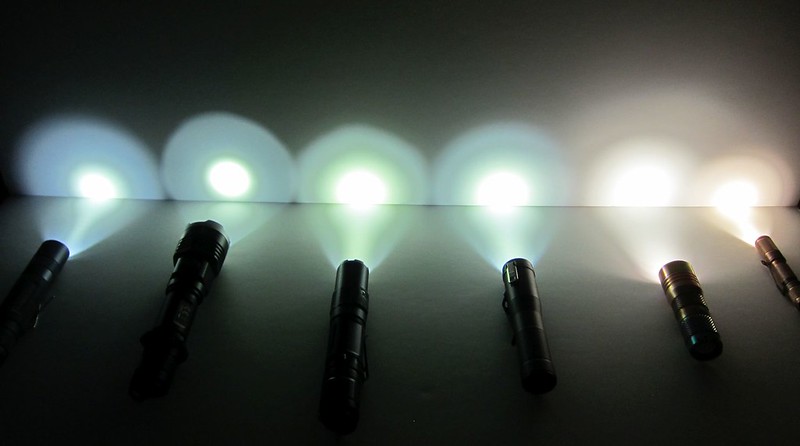
Output
Nitecore rates the P16 TAC's out on High at 1000 lumens. Tested with a Nitecore NL1834 3400mAh battery, I measured a higher 1063 lumens at turn on and 1051 lumens at 30 seconds.
Over the first 5.5 minutes output slowly dropped to 991 lumens before declining faster to 822 lumens by 8.5 minutes. According to the P16 TAC's manual, output is reduced at the 5 minute mark "to prevent overheating and extend battery life." I measured a peak temperature at the head at 130F (54C).
It held 832 lumens until minute 21 when output dropped to 626 lumens. Output was then flat through 90 minutes. Eventually 10% of original output was hit at 2 hours and 14 minutes – outperforming the 1 hour 15 minute runtime projected by Nitecore "based on theoretical arithmetic."
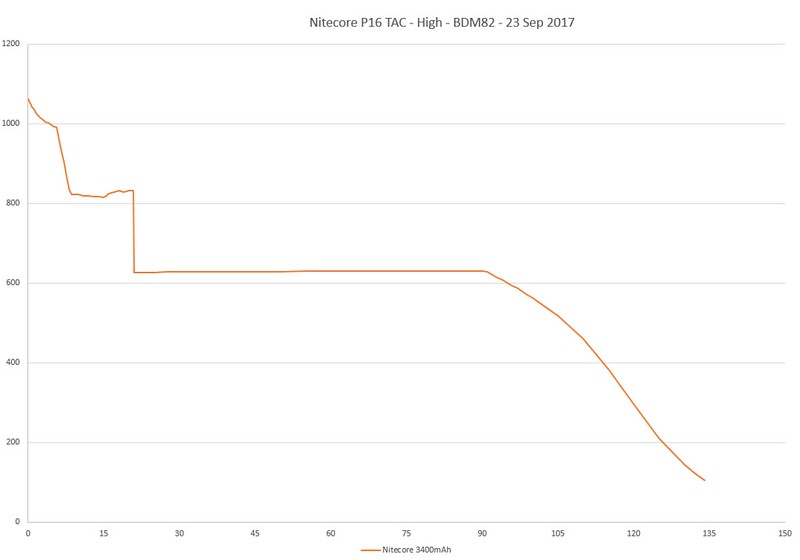
After 6 hours and 20 minutes the light powered off completely. Battery voltage was 2.83v; the cell's internal protection circuit had not been tripped.
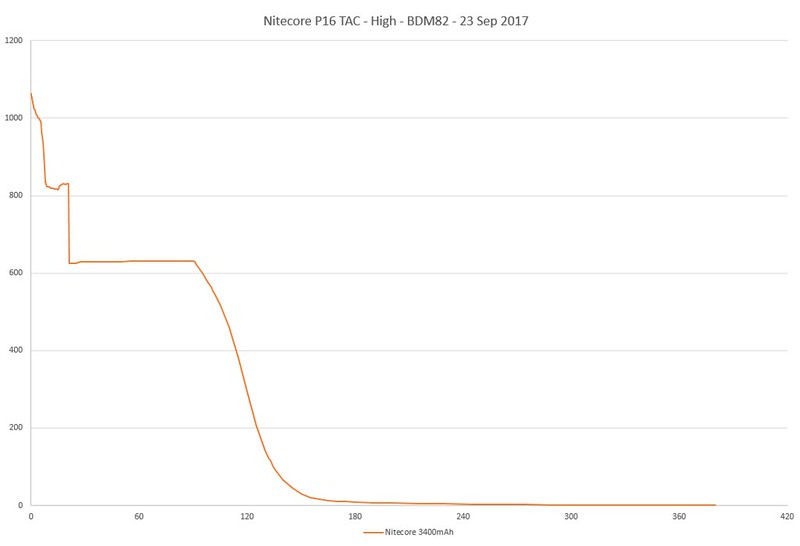
Medium is rated at 240 lumens. I measured exactly 240 lumens!
Output was flat through 7 hours and 5 minutes. As the end neared, the P16 TAC climbed to 285 lumens before crashing down. Runtime to 10% was 7 hours 36 minutes – a half hour longer than Nitecore's 7 hour rating.
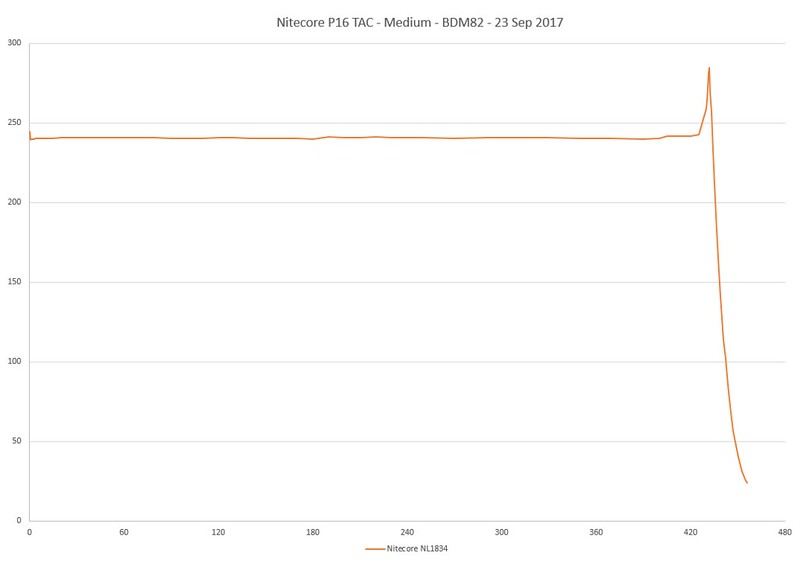
The P16 eventually powered off about 12 hours and 24 minutes into the test.
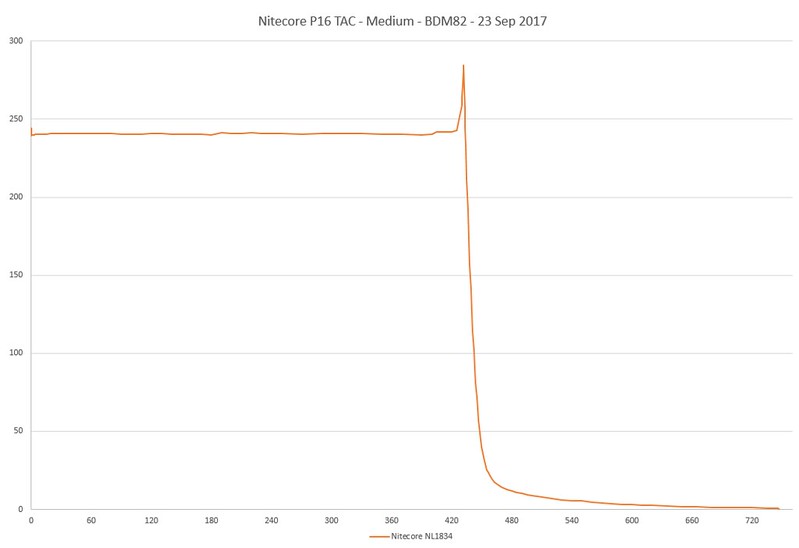
Low is rated at 60 lumens by Nitecore. I measured 49. Runtime is reported at 33 hours by Nitecore but was not tested.
Ultralow is rated at 1 lumen. I measured 1.8. Runtime is reported at 600 hours by Nitecore but was not tested.
Limited to button top cells, I also tested with an unprotected Samsung 30Q button top cell. Turbo output was a little higher – 34 more at turn on and 12 more at 30 seconds. Lower modes showed no difference from the Nitecore protected cell.
All outputs:
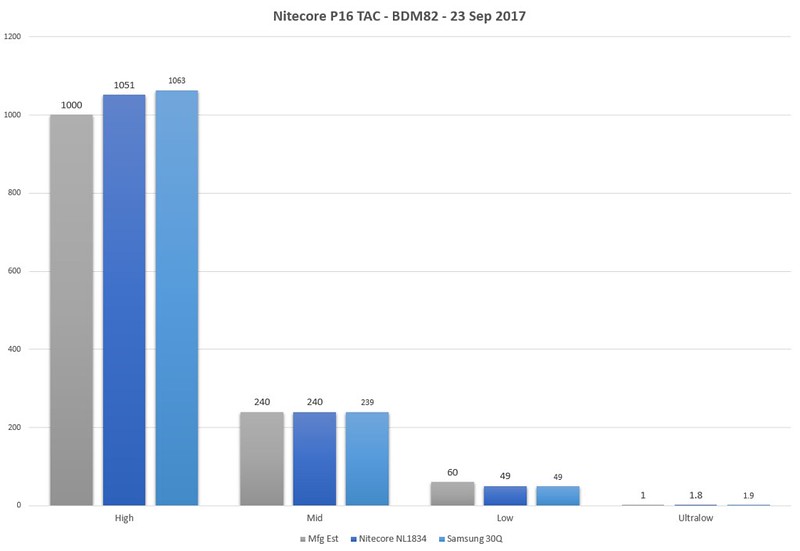
All tests were completed with an ambient temperature of 78-83F.
Battery Protection
The battery's own low-voltage protection was not tripped on any tests. The P16 TAC's own low-voltage cut-off protected the cells from over-discharging.
Throw
I tested throw distance at 1.46 meters and the resulting candela was 26,453 - equivalent to 325 meters of throw. This is slightly higher than Nitecore's ratings of 22,000 candela and 300 meters.
PWM
I did not detect PWM with my eyes on any mode using the "mirror test". A CMOS camera showed very high frequency PWM on Low and Medium, but I do not expect most users would ever sense its presence.
Parasitic Drain
The P16 TAC uses a mechanical tail switch so there is no parasitic drain.
Durability
The P16 TAC is rated to survive a drop up to 1.5 meters. As this is a Tactical and hunting light, it should be extra tough and able to take the recoil of a firearm.
I dropped it from 5 ft onto wood repeatedly at various angles. I swung both the head and tail of the light against various hard surfaces; the light never flickered or stopped working. This doesn't guarantee the P16 TAC is impervious to damage but it shows the light isn't particularly fragile.
Outdoor Beamshots
All photos taken with a Canon SD4000IS camera. 1/4" exposure, ISO800, Daylight white balance, F2.5.
Approximate distances: White deck railing @ 15 ft., white fence in distance @ 75 ft., center of boat @ 100 ft.
Control shot:

Low:
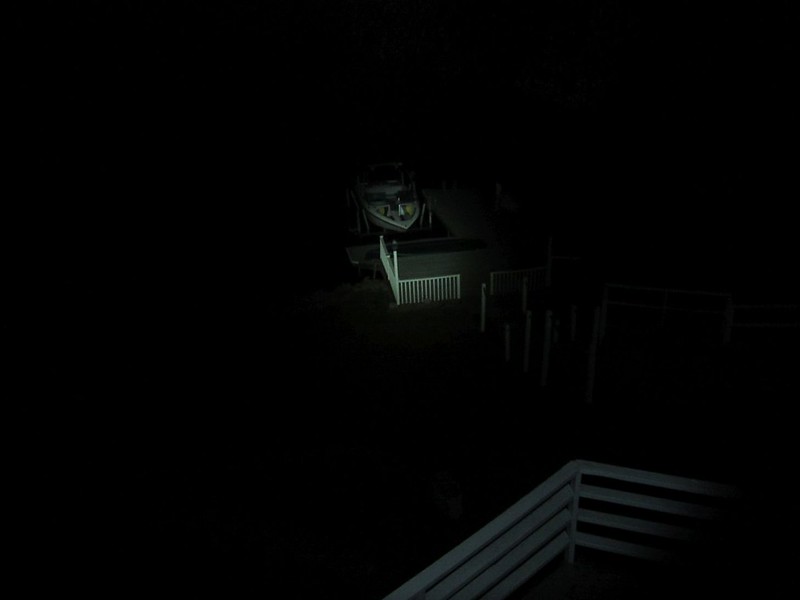
Med:
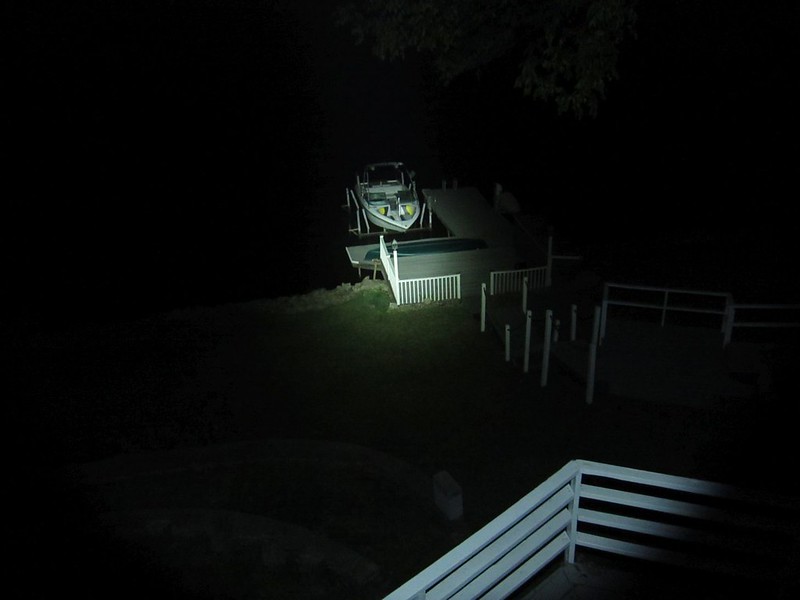
High:
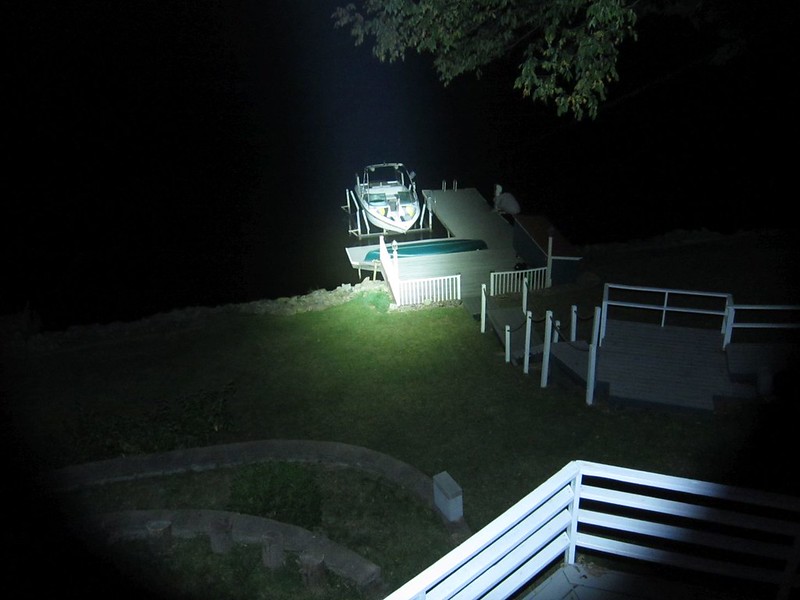
Ultralow not shown.
Interface
The interface is very straightforward. Tail switch to turn on/off; side switch to change outputs.
From off:
· Short press the tail switch activate the last mode used momentarily
· Fully press the tail switch to activate the last mode used indefinitely
From on:
· Short press the Mode switch to cycle UL->L->M->H…->UL
· Long press the Mode switch to access and cycle Strobe->SOS->Beacon…->Strobe; short press to resume normal modes
· Fully press the tail switch to turn off
All normal modes and strobe are memorized. SOS and Beacon modes are not memorized.
Problems
No problems were experienced while testing the Nitecore P16 TAC.
Commentary
The P16 TAC is a solid light. It's easy to use. It can take drops without failing. It can be carried with pocket clip, lanyard, or holster. It is compatible with various mounts and remote tail switches. It outperforms Nitecore's published output, runtime, and throw ratings. Ultralow is under 2 lumens and mode spacing overall is logical and progressive. These are all positives going for the P16 TAC.
But that said, it's a tough light to get excited about. The tint isn't special. There are no extreme specifications or unique modes. There are no particularly unique design features. Neither output nor runtimes are groundbreaking.
The P16 TAC isn't exciting; it just does what's expected or a bit more. Ultimately I suppose that's what the intended audience – hunters and tactical users – are going for.
Owners of the older P16 (from 2013) will have a hard time justifying the upgrade to the P16 TAC. Output, throw, and efficiency are all up slightly, but not a lot otherwise changes. The P16 also had a battery indicator under the Mode switch; this feature is not in the P16 TAC.
Overall the P16 TAC is a straightforward tactical light that satisfies expectations but lacks features to stand out from the competition.
Lux Meter: Dr. Meter LX1330B
Integrating "sphere": Homebuilt tube-style device calibrated on other known lights and test results. Numbers should be considered relative to each other and my other review figures but accuracy is in no way certified or guaranteed.
Camera: Canon SD4000IS
Multimeter: Craftsman 82170

Here is a summary of the XT2CR as tested, for those not inclined to read the full review:

The Nitecore P16 TAC is an upgrade to the original P16 released in the fall of 2013.
Skip to the commentary section at bottom to read my subjective notes on the P16 TAC and changes from the P16.
Disclaimer: This light was provided free of charge by Nitecore Store for review.
Unboxing
The P16 TAC is packaged in a black and yellow retail box in the same style as other Nitecore flashlights.
The box front promotes the 1000 lumen output, 300 meter beam distance, impact absorption spring, 4 brightness levels, and 3 special modes.

The back of the box has verbiage promoting much of the same information as was found on the front. It declares the P16 TAC an "ultimate lighting tool for tactical users and hunters".

One left side of the box promotes these hunting and tactical uses.

The right side has the P16 TAC's specifications.

Inside the box a plastic tray holds the P16 TAC. The accessories are tucked next to the P16 TAC from the underside of the tray.

Included is a holster, manual, warranty card, spare o-rings, spare tail switch boot, pocket clip, cigar ring, and lanyard.

The manual is in 9 languages (English, Spanish, German, French, Polish, Japanese, Romanian, Chinese, and Korean); each language's section is complete as the text is quite small.
It is available online here:
Nitecore backs the P16 TAC with a 5 year warranty.
Design
The P16 TAC is a traditional design with a single 18650 size battery tube and larger reflector. The light measures 154 mm long, 25.4 mm wide at the body, and 40 mm at the head. Weight is 142 g without battery. These are my measurements; Nitecore's specifications match other than the length is reported at 151 mm and weight at 136 g.
The 40 mm head size makes it compatible with a variety of filters, wands, and diffusers available from Nitecore. The 25.4 mm (1 in) body size is the standard size for weapon and bicycle mounts.
Here is the P16 TAC alongside other single 18650 flashlights.
L to R: Nitecore TM03, Nitecore P16 TAC, Zanflare F1, Klarus XT2CR, Convoy S2+, ThorFire VG-15S, Nitecore Concept 1.

The head of light has a silver-colored crenulated bezel, glued in place and non-removable. Behind the bezel on the side of the head is a "HOT" warning nicely aligned with the mode switch. The glass is AR-coated.

The reflector is smooth and deep. It had one small but insignificant ripple-like imperfection near the outer edge (visible at top in this picture). The beam was unaffected.

The XM-L2 U3 LED is perfectly centered.

The side of the head has four cooling fins ahead of the pentagonal section housing the Mode switch. The mode switch is not backlit.

The Nitecore Logo, website, and model name are located on the battery tube. Knurling is consistent and adds a mild amount of grip to the P16 TAC.

The opposite side of the battery tube has the registration and disposal information.

The reversible titanium-plated stainless pocket clip attaches to the battery tube. I would expect most users to use the holster instead of pocket clip given the light's size, but the flexibility is nonetheless nice.
The clip attaches securely but is still reasonably easy to remove and replace without damaging the anodization thanks to the upturned ends on the clip's arms.

It can be attached for head-up carry/attachment as well.

The cigar ring attaches ahead of the tail cap and provides useful grip when holding the P16 TAC overhand and prevents the light from rolling away when laid down. It also provides a lanyard attachment point redundant with the tail's holes. When the cigar ring is in place the pocket clip cannot be attached head-down.

The tail has a forward clicky switch that enables momentary on; if switch is half-pressed, the light will turn on in whatever mode was last used while the switch is held. Nitecore includes a spare rubber switch boot in case the original suffers damage in use. The switch boot has the Nitecore "N" and has excellent feel. Pressure to activate the switch is moderate – not too easy and not too stiff.

Nitecore offers a remote switch that can be used with the P16 TAC.
Two flat sections on tail provide lanyard attachment points and tailstand capability, though tailstanding requires a flat surface.

Inside, the tail has a gold-colored spring. The tail switch assembly can be disassembled (for cleaning or boot replacement) using a set of snap ring pliers to unscrew the retaining ring.

Threads are triangular cut and very well lubricated. They are also anodized, so a quarter turn of the tail will mechanically lock out the P16 TAC. An o-ring prevents water ingress to achieve the IPX-8 (2m) rating.

The P16 TAC is designed as a weapon-mountable tactical light; because of this it has a spring on the head-end as well to absorb shock – as advertised on the front of the box. The spring is not visible, blocked by the polarity protection disc used by Nitecore to protect against incorrect battery insertion. Button top batteries are required; flat tops will not function.

(It's also difficult to photograph as the battery tube is glued into the head.)
The included holster holds the PD16 TAC with the head up. It works with the pocket clip or cigar ring in place. It has a belt loop, a hook-and-loop strap, and a D ring so it can be carried a variety of ways.
Performance
Beam
The smooth reflector produces a very defined hotspot. The corona is a little jagged but relatively small. While most of the lumens go into the hotspot, the spill is still bright enough to be useful.

Tint
The tint is typical for the XML-2; the hotspot is a creamy neutral with some tint shift towards cooler blue in the spill.
To demonstrate the relative color balance, here is the P16 TAC flanked by lights with emitters of various tints and temperatures.
L to R: Convoy S2+ with cool XM-L U2 1B, Nitecore P16 TAC with XM-L2 U3, Klarus XT2CR with XHP35 HD E4, Nitecore C1 with XHP35 HD E2, Astrolux S41S with neutral 219B, Lumintop Tool with warm 219B.

Output
Nitecore rates the P16 TAC's out on High at 1000 lumens. Tested with a Nitecore NL1834 3400mAh battery, I measured a higher 1063 lumens at turn on and 1051 lumens at 30 seconds.
Over the first 5.5 minutes output slowly dropped to 991 lumens before declining faster to 822 lumens by 8.5 minutes. According to the P16 TAC's manual, output is reduced at the 5 minute mark "to prevent overheating and extend battery life." I measured a peak temperature at the head at 130F (54C).
It held 832 lumens until minute 21 when output dropped to 626 lumens. Output was then flat through 90 minutes. Eventually 10% of original output was hit at 2 hours and 14 minutes – outperforming the 1 hour 15 minute runtime projected by Nitecore "based on theoretical arithmetic."

After 6 hours and 20 minutes the light powered off completely. Battery voltage was 2.83v; the cell's internal protection circuit had not been tripped.

Medium is rated at 240 lumens. I measured exactly 240 lumens!
Output was flat through 7 hours and 5 minutes. As the end neared, the P16 TAC climbed to 285 lumens before crashing down. Runtime to 10% was 7 hours 36 minutes – a half hour longer than Nitecore's 7 hour rating.

The P16 eventually powered off about 12 hours and 24 minutes into the test.

Low is rated at 60 lumens by Nitecore. I measured 49. Runtime is reported at 33 hours by Nitecore but was not tested.
Ultralow is rated at 1 lumen. I measured 1.8. Runtime is reported at 600 hours by Nitecore but was not tested.
Limited to button top cells, I also tested with an unprotected Samsung 30Q button top cell. Turbo output was a little higher – 34 more at turn on and 12 more at 30 seconds. Lower modes showed no difference from the Nitecore protected cell.
All outputs:

All tests were completed with an ambient temperature of 78-83F.
Battery Protection
The battery's own low-voltage protection was not tripped on any tests. The P16 TAC's own low-voltage cut-off protected the cells from over-discharging.
Throw
I tested throw distance at 1.46 meters and the resulting candela was 26,453 - equivalent to 325 meters of throw. This is slightly higher than Nitecore's ratings of 22,000 candela and 300 meters.
PWM
I did not detect PWM with my eyes on any mode using the "mirror test". A CMOS camera showed very high frequency PWM on Low and Medium, but I do not expect most users would ever sense its presence.
Parasitic Drain
The P16 TAC uses a mechanical tail switch so there is no parasitic drain.
Durability
The P16 TAC is rated to survive a drop up to 1.5 meters. As this is a Tactical and hunting light, it should be extra tough and able to take the recoil of a firearm.
I dropped it from 5 ft onto wood repeatedly at various angles. I swung both the head and tail of the light against various hard surfaces; the light never flickered or stopped working. This doesn't guarantee the P16 TAC is impervious to damage but it shows the light isn't particularly fragile.
Outdoor Beamshots
All photos taken with a Canon SD4000IS camera. 1/4" exposure, ISO800, Daylight white balance, F2.5.
Approximate distances: White deck railing @ 15 ft., white fence in distance @ 75 ft., center of boat @ 100 ft.
Control shot:

Low:

Med:

High:

Ultralow not shown.
Interface
The interface is very straightforward. Tail switch to turn on/off; side switch to change outputs.
From off:
· Short press the tail switch activate the last mode used momentarily
· Fully press the tail switch to activate the last mode used indefinitely
From on:
· Short press the Mode switch to cycle UL->L->M->H…->UL
· Long press the Mode switch to access and cycle Strobe->SOS->Beacon…->Strobe; short press to resume normal modes
· Fully press the tail switch to turn off
All normal modes and strobe are memorized. SOS and Beacon modes are not memorized.
Problems
No problems were experienced while testing the Nitecore P16 TAC.
Commentary
The P16 TAC is a solid light. It's easy to use. It can take drops without failing. It can be carried with pocket clip, lanyard, or holster. It is compatible with various mounts and remote tail switches. It outperforms Nitecore's published output, runtime, and throw ratings. Ultralow is under 2 lumens and mode spacing overall is logical and progressive. These are all positives going for the P16 TAC.
But that said, it's a tough light to get excited about. The tint isn't special. There are no extreme specifications or unique modes. There are no particularly unique design features. Neither output nor runtimes are groundbreaking.
The P16 TAC isn't exciting; it just does what's expected or a bit more. Ultimately I suppose that's what the intended audience – hunters and tactical users – are going for.
Owners of the older P16 (from 2013) will have a hard time justifying the upgrade to the P16 TAC. Output, throw, and efficiency are all up slightly, but not a lot otherwise changes. The P16 also had a battery indicator under the Mode switch; this feature is not in the P16 TAC.
Overall the P16 TAC is a straightforward tactical light that satisfies expectations but lacks features to stand out from the competition.
Lux Meter: Dr. Meter LX1330B
Integrating "sphere": Homebuilt tube-style device calibrated on other known lights and test results. Numbers should be considered relative to each other and my other review figures but accuracy is in no way certified or guaranteed.
Camera: Canon SD4000IS
Multimeter: Craftsman 82170

